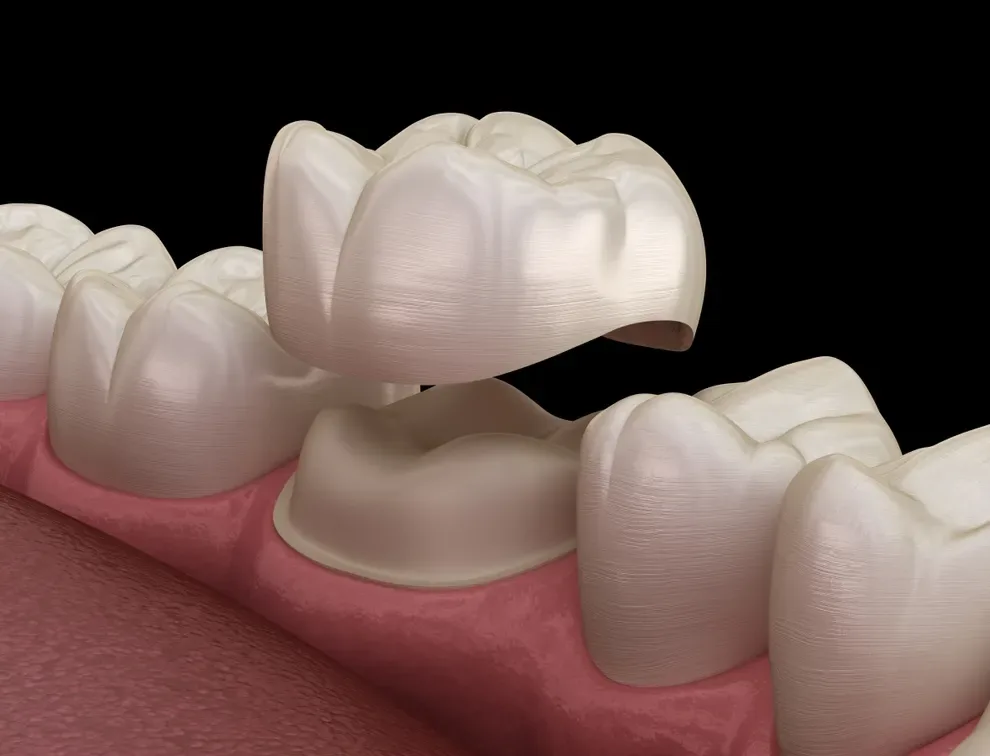Cost of Dental Crowns With & Without Insurance

Table of Contents
- Cost Breakdown
- Are Molar Crowns More Affordable vs. Front Teeth Crowns?
- Cheap Crowns
- Insurance Coverage
- Consider a Dental School
- Dental Crowns?
- Diagnostic Costs Explained
- Cost of Dental Crowns
- Aftercare
- Payment Options
The cost of a crown will depend on the material you choose, but it will likely fall within the range of $500 to $2,500 per crown. The procedure usually requires additional fees for exams, x-rays, procedural costs, and any needed prep work before the crown is put on.
If you have a medical reason for a dental crown, also known as a cap, your dental insurance should cover part of the procedure and device itself. If you want dental crowns for entirely cosmetic reasons, your insurance is not likely to cover the procedure.
If you don’t have dental insurance, you’ll need to pay for dental crowns out of pocket. Some dentists may offer a slightly discounted rate for customers who don’t have any dental insurance.
What Are Dental Crowns?
A dental crown or cap is a device that covers an existing tooth or part of an existing tooth, to recreate the shape of the original tooth and keep your mouth healthy. If you need to have a root canal, have a tooth removed, or have a dental bridge put in your mouth, your dentist may use a cap to strengthen the tooth or the place where your tooth was.
There are several uses for teeth capping, which can be made from a range of materials. There are pros and cons to each type and use of dental crowns. One of the factors you and your dentist must consider is the cost.
Why Do Dental Crowns Cost so Much?
Crowns can vary greatly in price. Some common reasons a cap may be more expensive include the following:
The general cost of living in your area
The shape, size, and location of the tooth you need replaced
The material used to make the crown
The skill of the artist who makes the crown
Other procedures you need leading up to the crown’s placement
Your dentist’s skill and experience
The timeline of getting an implant will vary somewhat, depending on the specifics of your case.
Your dentist will take an impression of the tooth, so a crown sculptor can create the right size and shape for your mouth. Then, on your second visit, your dentist will install the crown.
Dental crowns are important if you need to cover or replace a tooth and they can be expensive, depending on factors like material, your dentist’s skill, and where the crown is placed.
Diagnostic Costs Explained
Dental crowns are medical devices, and you must go through several steps with a qualified dentist to get ready for the procedure. Each one of those steps can come with expenses.
Those expenses can involve the following:
Dental Visits
Before you get a crown to replace or cover a tooth, you will typically need two separate dental visits. The first visit is the diagnosis, during which your dentist looks at the affected tooth and creates a treatment plan. They will examine the structure of your tooth to make sure it can support a crown, and they may begin shaving the tooth down so the crown can be installed.
A dental office visit can cost $50 to $350.
Diagnostic X-Rays
Your dentist needs to examine your tooth roots to ensure that your mouth is healthy and ready for a crown. Several different types of x-rays are available, and they all come with different costs.
A dental x-ray can cost between $20 to $250.
Tooth Extraction
If the tooth is severely damaged, it may need to be removed. Dentists provide a local anesthetic via injection to numb the tissue, and they then remove the tooth. Simple extractions (where the tooth is easy to remove) generally cost less than more complicated removals.
Pulling a tooth can cost between $75 and $650.
Dental Implant
If you do have a tooth removed, there’s nothing for a crown to attach to. A dental implant is a post attached to the jaw, and the crown can be placed on the top.
Dental implants can cost between $1,000 and $3,000.

Breaking Down the Cost of Dental Crowns
Ask your dentist about specific costs associated with your cap. They will be able to tell you specifics about the implant sculptor they work with, how they charge for the procedure, and what you can expect for treatment leading up to, and after, the procedure.
Estimates of dental crown cost break down based on materials. A particular option might work best for you based on cost and how the material will look cosmetically once it is implanted.
You may need to cover additional costs associated with teeth capping. For example, your dentist will need x-rays to examine your teeth and jaw, which may cost $20 to $250, depending on whether you have them at your initial consultation or not. If you need a root canal, the expense of that procedure can be as high as $2,000. Your dentist may need to build up the bone around the area where the tooth once was, which can cost $250 per tooth.
If you need to reduce your overall bill, there are some dentists that provide services on a sliding scale or offer low-cost office visits. Research local dentists, and inquire about costs and possible discounts.
Dental Crown Cost in Aftercare
When your dental crown procedure is complete, you’ll need some supplies to help your mouth and associated tissues heal. Sometimes, that comes with added costs.
You may face expenses associated with the following:
Prescription painkillers
Ice packs
Bandages
Rinses
These fees can be very minimal, but it’s important to keep them in mind. If you’re struggling to cover these fees, talk to your dentist.
You may also need a follow-up visit to ensure that your mouth is healing. Sometimes, those visits are covered in the surgical payments you already made. Sometimes, they’re not.
This is one of the more natural and durable combinations for a crown.
Costs range from $500 to $1,500 per tooth. Without insurance, your average cost will be about $1,093. With insurance, you may pay as little as $282 or as much as $1,000.
Are Molar Crowns More Affordable than Front Teeth Crowns?
Again, when it comes to crowns, the most important factor in cost is the material used. Molar crowns may be considered more affordable because more people are willing to use the least expensive crowns available on these less visible teeth.
However, it’s also important to consider the additional fees that could be involved with a molar crown if there are problems like decay, infection, or tooth damage.
People are more likely to have decay in their back teeth. There are lots of grooves and “hiding spots” for decay, and people might pay less attention (or not be able to see or reach) their molars when cleaning their teeth. Procedures like root canals may be necessary in these areas.
Many people choose durable metal crowns for back teeth rather than the most expensive (and more fragile) porcelain crowns:
| Material | Average cost without insurance (per tooth, crown only, not including procedure costs) | Average cost with insurance (per tooth, crown only, not including procedure costs) |
|---|---|---|
| Porcelain-fused-to-metal crowns | $1,093 | $282–$1,000 |
| Metal or gold alloy crowns | $1,353 | $519–$1,140 |
| All-porcelain crowns | $1,430 | $530–$1,875 |
Why ‘Cheap’ Crowns aren’t Worth It
Like most things in life, you get what you pay for when it comes to dental crowns.
Most professional dentists will use porcelain-infused metal crowns, metal or gold alloy crowns, or all-porcelain crowns. These are all durable materials that are commonly used. Metal crowns will give you the cheapest option, but they might not look as good as porcelain crowns.
If a dentist is offering an incredibly low price for a crown, inquire about the material used. It isn’t worth it to choose cheap alloys, which can bend easily, cast poorly, or corrode early.
Insurance Coverage Helps a Little
Dental insurance is designed to help cover expenses associated with your oral health. If you have coverage, you could get at least some help with the final bill.
These examples of payments from major dental insurance providers can help you understand the costs:
Humana: A full-coverage plan may pay as much as 50% of the final bill.
Delta Dental: A plan may cover all of the costs, as long as your doctor proves that the tooth is at least 50% damaged.
Anthem: A plan may cover 50% of the costs associated with crowns
Before you schedule your appointment for a crown, talk to your insurance provider and ask what’s covered and what you’ll be asked to pay for the procedure. Find out about added expenses, too. For example, many dental plans have a maximum annual coverage limit of between $1,000 and $1,500. And if you choose an expensive crown, the additional cost may not be covered by your insurance, and you will have to pay it out of pocket.
Payment Options & Assistance
Finding the money to pay for a dental crown isn’t always easy, but you do have options.
A health savings account (HSA) allows you to set aside money for medical expenses, including dental crowns. You can put money in the account, and your employer might do the same. This can be a good source of funding for your healthy smile.
A flexible spending account (FSA) is similar to an HSA. You can set aside money for medical expenses, and your employer might do the same. Typically, you’re required to spend all of the funds in your FSA by the end of the calendar year.
Some dental professionals offer payment plans that can help you cover the cost of big procedures, including crowns. These programs can vary dramatically, and not all dental professionals offer them.
Some dentists also accept credit cards for payment. This option allows you to pay for the work you need now while paying the bill in increments later on.
Consider a Dental School for Affordable Dental Crowns
Your best bet for a cheaper crown option may be a dental school. Many dental schools offer services that include crowns.
Some may have a faculty member performing services as students watch. Others may have senior students performing the procedures under the guidance of their professor.
Depending on what you’re comfortable with, you may wish to contact dental programs in your area and inquire about their clinic services.
